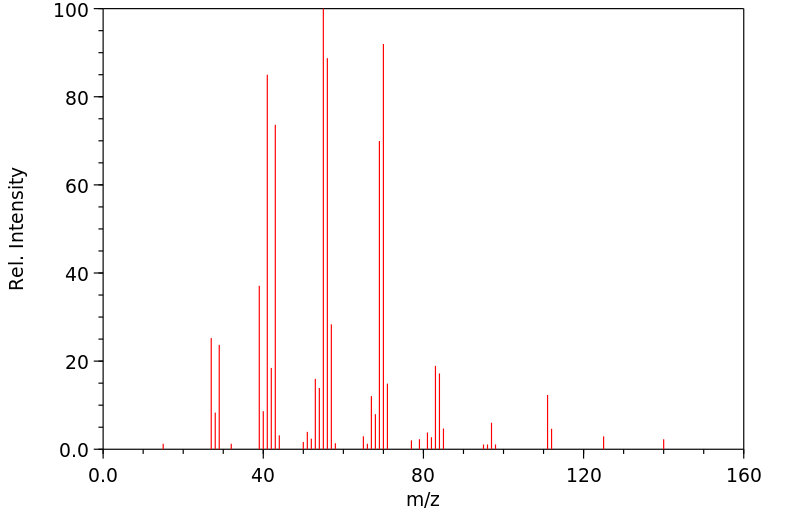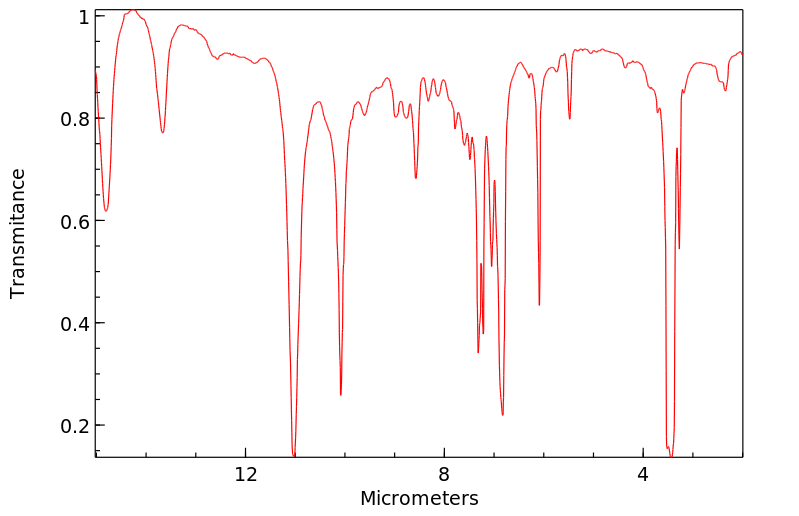3,7-二甲基-1-辛烯 | 4984-01-4
中文名称
3,7-二甲基-1-辛烯
中文别名
——
英文名称
3,7-dimethyl-oct-1-ene
英文别名
3,7-dimethyl-1-octene;3,7-dimethyloctene;(+/-)-3,7-dimethyl-oct-1-ene;(+/-)-3,7-Dimethyl-oct-1-en;3,7-Dimethyl-oct-1-en;γ.η-Dimethyl-α-octylen;3,7-dimethyloct-1-ene
CAS
4984-01-4
化学式
C10H20
mdl
MFCD00042868
分子量
140.269
InChiKey
KSXTZYRIJKDCEA-UHFFFAOYSA-N
BEILSTEIN
——
EINECS
——
-
物化性质
-
计算性质
-
ADMET
-
安全信息
-
SDS
-
制备方法与用途
-
上下游信息
-
文献信息
-
表征谱图
-
同类化合物
-
相关功能分类
-
相关结构分类
物化性质
-
熔点:-56.93°C (estimate)
-
沸点:154-156 °C (lit.)
-
密度:0.733 g/mL at 20 °C (lit.)
-
闪点:52 °C
-
溶解度:氯仿(微溶)、甲醇(微溶)
-
保留指数:963
计算性质
-
辛醇/水分配系数(LogP):4.6
-
重原子数:10
-
可旋转键数:5
-
环数:0.0
-
sp3杂化的碳原子比例:0.8
-
拓扑面积:0
-
氢给体数:0
-
氢受体数:0
安全信息
-
危险等级:3.2
-
危险类别码:R10
-
危险品运输编号:UN 3295 3/PG 3
-
包装等级:III
-
危险类别:3.2
-
WGK Germany:3
SDS
Section 1. IDENTIFICATION OF THE SUBSTANCE/MIXTURE
Product identifiers
Product name : 3,7-Dimethyl-1-octene
CAS-No. : 4984-01-4
Relevant identified uses of the substance or mixture and uses advised against
Identified uses : Laboratory chemicals, Manufacture of substances
Section 2. HAZARDS IDENTIFICATION
Classification of the substance or mixture
Classification according to Regulation (EC) No 1272/2008 [EU-GHS/CLP]
Flammable liquids (Category 3)
Classification according to EU Directives 67/548/EEC or 1999/45/EC
Flammable.
Label elements
Labelling according Regulation (EC) No 1272/2008 [CLP]
Pictogram
Signal word Warning
Hazard statement(s)
H226 Flammable liquid and vapour.
Precautionary statement(s) none
Supplemental Hazard none
Statements
According to European Directive 67/548/EEC as amended.
Hazard symbol(s) none
R-phrase(s)
R10 Flammable.
S-phrase(s) none
Other hazards - none
Section 3. COMPOSITION/INFORMATION ON INGREDIENTS
Substances
Formula : C10H20
Molecular Weight : 140,27 g/mol
Section 4. FIRST AID MEASURES
Description of first aid measures
General advice
Consult a physician. Show this safety data sheet to the doctor in attendance.
If inhaled
If breathed in, move person into fresh air. If not breathing, give artificial respiration. Consult a physician.
In case of skin contact
Wash off with soap and plenty of water. Consult a physician.
In case of eye contact
Flush eyes with water as a precaution.
If swallowed
Do NOT induce vomiting. Never give anything by mouth to an unconscious person. Rinse mouth with
water. Consult a physician.
Most important symptoms and effects, both acute and delayed
Indication of any immediate medical attention and special treatment needed
no data available
Section 5. FIREFIGHTING MEASURES
Extinguishing media
Suitable extinguishing media
Use water spray, alcohol-resistant foam, dry chemical or carbon dioxide.
Special hazards arising from the substance or mixture
Carbon oxides
Advice for firefighters
Wear self contained breathing apparatus for fire fighting if necessary.
Further information
Use water spray to cool unopened containers.
Section 6. ACCIDENTAL RELEASE MEASURES
Personal precautions, protective equipment and emergency procedures
Avoid breathing vapors, mist or gas. Remove all sources of ignition. Beware of vapours accumulating to
form explosive concentrations. Vapours can accumulate in low areas.
Environmental precautions
Prevent further leakage or spillage if safe to do so. Do not let product enter drains.
Methods and materials for containment and cleaning up
Contain spillage, and then collect with an electrically protected vacuum cleaner or by wet-brushing and
place in container for disposal according to local regulations (see section 13).
Reference to other sections
For disposal see section 13.
Section 7. HANDLING AND STORAGE
Precautions for safe handling
Avoid inhalation of vapour or mist.
Keep away from sources of ignition - No smoking.Take measures to prevent the build up of electrostatic
charge.
Conditions for safe storage, including any incompatibilities
Store in cool place. Keep container tightly closed in a dry and well-ventilated place. Containers which are
opened must be carefully resealed and kept upright to prevent leakage.
Recommended storage temperature: 2 - 8 °C
Store under inert gas.
Specific end uses
no data available
Section 8. EXPOSURE CONTROLS/PERSONAL PROTECTION
Control parameters
Components with workplace control parameters
Exposure controls
Appropriate engineering controls
Handle in accordance with good industrial hygiene and safety practice. Wash hands before breaks and
at the end of workday.
Personal protective equipment
Eye/face protection
Face shield and safety glasses Use equipment for eye protection tested and approved under
appropriate government standards such as NIOSH (US) or EN 166(EU).
Skin protection
Handle with gloves. Gloves must be inspected prior to use. Use proper glove removal technique
(without touching glove's outer surface) to avoid skin contact with this product. Dispose of
contaminated gloves after use in accordance with applicable laws and good laboratory practices.
Wash and dry hands.
The selected protective gloves have to satisfy the specifications of EU Directive 89/686/EEC and
the standard EN 374 derived from it.
Body Protection
impervious clothing, Flame retardant antistatic protective clothing, The type of protective
equipment must be selected according to the concentration and amount of the dangerous
substance at the specific workplace.
Respiratory protection
Where risk assessment shows air-purifying respirators are appropriate use a full-face respirator
with multi-purpose combination (US) or type ABEK (EN 14387) respirator cartridges as a backup
to engineering controls. If the respirator is the sole means of protection, use a full-face supplied air
respirator. Use respirators and components tested and approved under appropriate government
standards such as NIOSH (US) or CEN (EU).
Section 9. PHYSICAL AND CHEMICAL PROPERTIES
Information on basic physical and chemical properties
a) Appearance Form: clear, liquid
Colour: colourless
b) Odour no data available
c) Odour Threshold no data available
d) pH no data available
e) Melting point/freezing no data available
point
f) Initial boiling point and 154 - 156 °C
boiling range
g) Flash point 52 °C - closed cup
h) Evaporation rate no data available
i) Flammability (solid, gas) no data available
j) Upper/lower no data available
flammability or
explosive limits
k) Vapour pressure no data available
l) Vapour density no data available
m) Relative density 0,733 g/mL at 20 °C
n) Water solubility no data available
o) Partition coefficient: n- no data available
octanol/water
p) Autoignition no data available
temperature
q) Decomposition no data available
temperature
r) Viscosity no data available
s) Explosive properties no data available
t) Oxidizing properties no data available
Other safety information
no data available
Section 10. STABILITY AND REACTIVITY
Reactivity
no data available
Chemical stability
no data available
Possibility of hazardous reactions
no data available
Conditions to avoid
Heat, flames and sparks.
Incompatible materials
no data available
Hazardous decomposition products
Other decomposition products - no data available
Section 11. TOXICOLOGICAL INFORMATION
Information on toxicological effects
Acute toxicity
no data available
Skin corrosion/irritation
no data available
Serious eye damage/eye irritation
no data available
Respiratory or skin sensitization
no data available
Germ cell mutagenicity
no data available
Carcinogenicity
IARC: No component of this product present at levels greater than or equal to 0.1% is identified as
probable, possible or confirmed human carcinogen by IARC.
Reproductive toxicity
no data available
Specific target organ toxicity - single exposure
no data available
Specific target organ toxicity - repeated exposure
no data available
Aspiration hazard
no data available
Potential health effects
Inhalation
May be harmful if inhaled. May cause respiratory tract irritation.
Ingestion May be harmful if swallowed.
Skin May be harmful if absorbed through skin. May cause skin irritation.
Eyes May cause eye irritation.
Additional Information
RTECS: Not available
Section 12. ECOLOGICAL INFORMATION
Toxicity
no data available
Persistence and degradability
no data available
Bioaccumulative potential
no data available
Mobility in soil
no data available
Results of PBT and vPvB assessment
no data available
Other adverse effects
no data available
Section 13. DISPOSAL CONSIDERATIONS
Waste treatment methods
Product
Burn in a chemical incinerator equipped with an afterburner and scrubber but exert extra care in igniting
as this material is highly flammable. Offer surplus and non-recyclable solutions to a licensed disposal
company.
Contaminated packaging
Dispose of as unused product.
Section 14. TRANSPORT INFORMATION
UN number
ADR/RID: 3295 IMDG: 3295 IATA: 3295
UN proper shipping name
ADR/RID: HYDROCARBONS, LIQUID, N.O.S.
IMDG: HYDROCARBONS, LIQUID, N.O.S.
IATA: Hydrocarbons, liquid, n.o.s.
Transport hazard class(es)
ADR/RID: 3 IMDG: 3 IATA: 3
Packaging group
ADR/RID: III IMDG: III IATA: III
Environmental hazards
ADR/RID: no IMDG Marine pollutant: no IATA: no
Special precautions for user
no data available
Section 15. REGULATORY INFORMATION
This safety datasheet complies with the requirements of Regulation (EC) No. 1907/2006.
Safety, health and environmental regulations/legislation specific for the substance or mixture
no data available
Chemical Safety Assessment
no data available
Section 16. OTHER INFORMATION
Further information
Copyright 2012 Co. LLC. License granted to make unlimited paper copies for internal use
only.
The above information is believed to be correct but does not purport to be all inclusive and shall be
used only as a guide. The information in this document is based on the present state of our knowledge
and is applicable to the product with regard to appropriate safety precautions. It does not represent any
guarantee of the properties of the product. Corporation and its Affiliates shall not be held
liable for any damage resulting from handling or from contact with the above product. See
and/or the reverse side of invoice or packing slip for additional terms and conditions of sale.
反应信息
-
作为反应物:描述:参考文献:名称:Longinow; Margoliss, Bulletin de la Societe Chimique de France, 1929, vol. <4> 45, p. 165摘要:DOI:
-
作为产物:描述:参考文献:名称:Nooi,J.R. et al., Recueil des Travaux Chimiques des Pays-Bas, 1969, vol. 88, p. 398 - 410摘要:DOI:
文献信息
-
Controllable, Sequential, and Stereoselective C–H Allylic Alkylation of Alkenes作者:Ling Qin、Mohammed Sharique、Uttam K. TambarDOI:10.1021/jacs.9b08801日期:2019.10.30new C-C bonds represents a powerful approach to generate complex molecules from simple starting materials. However, a general and controllable method for the sequential conversion of a methyl group into a fully substituted carbon center remains a challenge. We report a new method for the selective and sequential replacement of three C-H bonds at the allylic position of propylene and other simple terminal
-
Acyclic monoterpenes as biofuels based on linalool and method for making the same申请人:THE UNITED STATES OF AMERICA AS REPRESENTED BY THE SECRETARY OF THE NAVY公开号:US09266798B1公开(公告)日:2016-02-23Acyclic monterpene alcohols, like linalool, to be converted through a series of highly efficient catalytic reactions a biogasoline blending component, and a drop-in biodiesel fuel.
-
A Fujiwara‐Moritani‐Type Alkenylation Using a Traceless Directing Group Strategy: A Rare Example of C−C Bond Formation towards the C2‐Carbon of Terminal Alkenes作者:Raheleh Pourkaveh、Maren Podewitz、Michael SchnürchDOI:10.1002/ejoc.202201179日期:2023.2.17ortho-position to a carboxylic acid group by employing simple olefins which do not carry electron-withdrawing groups. The acid initially acts as the directing group but is subsequently removed by decarboxylation. The process introduces an alkene in meta-position to an electron donating residue, which is complementary to classical electrophilic substitution reactions on aromatic systems.我们通过使用不携带吸电子基团的简单烯烃来描述与羧酸基团的正位烯化。酸最初充当定向基团,但随后通过脱羧去除。该工艺将烯烃以偏位引入电子供体残基,这与芳香族系统上的经典亲电取代反应互补。
-
One-Pot Formal Carboradiofluorination of Alkenes: A Toolkit for Positron Emission Tomography Imaging Probe Development作者:Mónica Rivas、Sashi Debnath、Sachin Giri、Yusuf M. Noffel、Xiankai Sun、Vladimir GevorgyanDOI:10.1021/jacs.3c04548日期:2023.9.6accessible alkenes as both prosthetic group precursors and coupling partners. The methodology features rapid sequential Markovnikov-selective iodofluorination and photoinduced Pd(0/I/II)-catalyzed alkyl Heck reaction as a mild and robust fluorine-18 (18F) radiochemical approach for positron emission tomography (PET) imaging probe development. A new class of prosthetic groups for PET imaging probe synthesis我们报告了第一个一锅正式烯烃碳硼氟化反应,采用易于获得的烯烃作为辅基前体和偶联伙伴。该方法的特点是快速连续马尔可夫尼科夫选择性碘氟化和光诱导 Pd(0/I/II) 催化烷基 Heck 反应,作为一种温和且稳定的氟 18 ( 18 F) 放射化学方法,用于正电子发射断层扫描 (PET) 成像探针的开发。用于 PET 成像探针合成的一类新型辅基以碘氟化中间体的形式分离出来,产率中等至优异。进行一锅正式烯基氟化反应,生成了 30 多种多种生物活性分子的类似物。通过富电子烯烃的直接碳(放射性)氟化,说明了 Pd(0/I/II) 歧管在 PET 探针开发中的进一步应用。这些方法已成功转化为放射性标记广泛的医学相关小分子,放射化学转化总体良好。该协议经过进一步优化,以适应无载体添加的条件,并为未来(前)临床翻译提供类似的效率。此外,辅基的放射合成在放射化学模块中实现自动化,以促进其在多步放射化学反应中的实际应用。
-
McQuillin,F.J.; Wood,M., Journal of the Chemical Society. Perkin transactions I, 1976, p. 1762 - 1768作者:McQuillin,F.J.、Wood,M.DOI:——日期:——
表征谱图
-
氢谱1HNMR
-
质谱MS
-
碳谱13CNMR
-
红外IR
-
拉曼Raman
-
峰位数据
-
峰位匹配
-
表征信息
同类化合物
高密聚乙烯
香叶醇
顺式3-甲基-2-己烯
顺式-5-癸烯
顺式-5-甲基-2-己烯
顺式-5-庚烯-1-炔
顺式-4-癸烷
顺式-4-甲基-2-戊烯
顺式-4-甲基-2-戊烯
顺式-3-癸烯
顺式-3-甲基-3-己烯
顺式-3-甲基-2-庚烯
顺式-3-戊烯-1-炔
顺式-3,4-二甲基-3-己烯
顺式-3,4-二甲基-2-戊烯
顺式-3,4-二甲基-2-戊烯
顺式-2-甲基-3-己烯
顺式-2-壬烯
顺式-2-丁烯-D1
顺式-1.1.1-三甲基-2-丁烯
顺式-1-甲基-2-环丙基乙烯
顺式-1-甲基-2-乙烯基环戊烷
顺式-1-环戊基-1-辛烯
顺式-1-氘代-3-甲基-1-丁烯
顺式-(9ci)-2,3,3a,7a-四氢-4-(1-甲基乙基)-1H-茚
顺式-(2-丁烯基)环丙烷
顺式,顺式-2,4-己二烯
顺-环辛烯
顺-9-二十一碳烯
顺-6-十三碳烯
顺-5-甲基-1,3,6-庚三烯
顺-4-辛烯
顺-4-壬烯
顺-3-辛烯
顺-3-甲基-2-戊烯
顺-3-壬烯
顺-3-十三碳烯
顺-2-辛烯
顺-2-癸烯
顺-2-戊烯
顺-2-庚烯
顺-2-己烯
顺-2-丁烯
顺-2,2-二甲基-3-己烯
顺-1,3-戊二烯
顺,顺-1,9-环十六烷二烯
顺,顺,顺-环癸-1,3,5-三烯
间戊二烯
间二(4-吡啶基)苯
镁,二-2-丁烯基-








